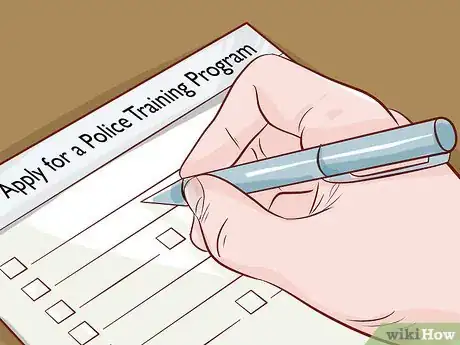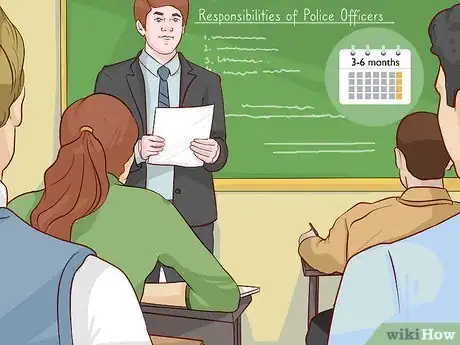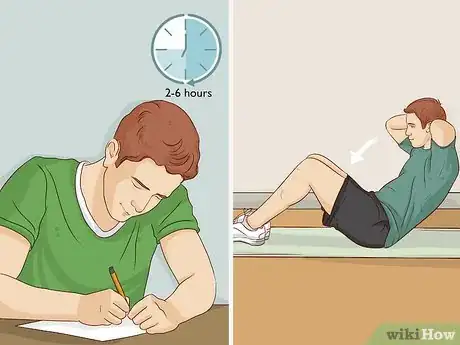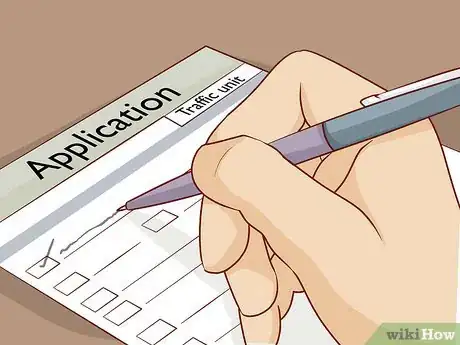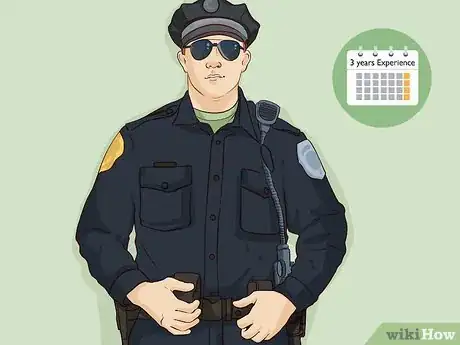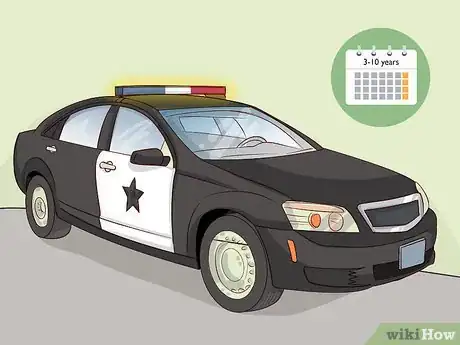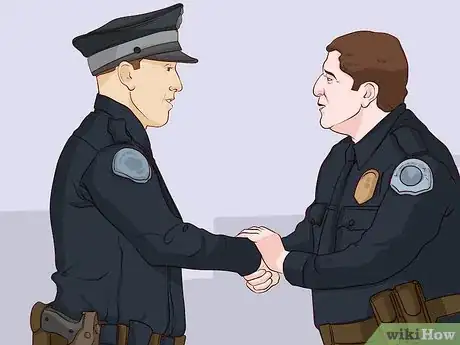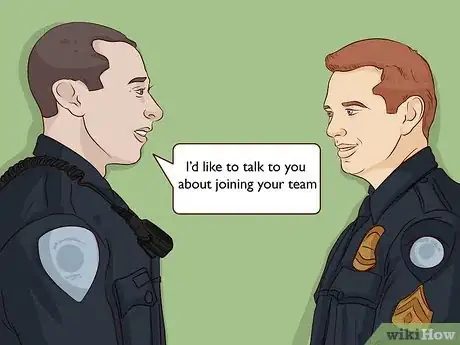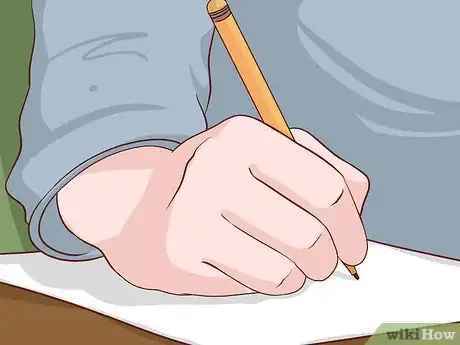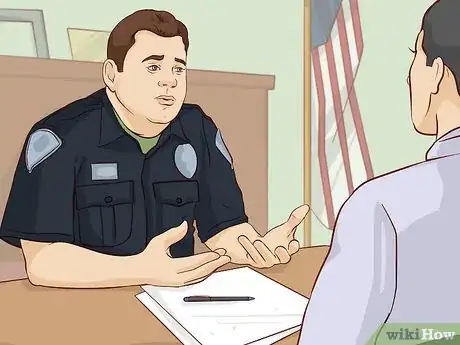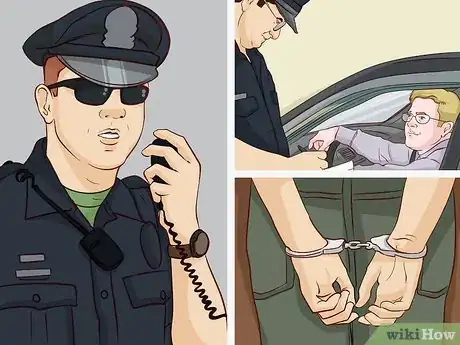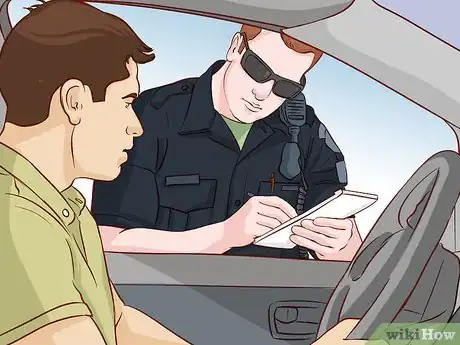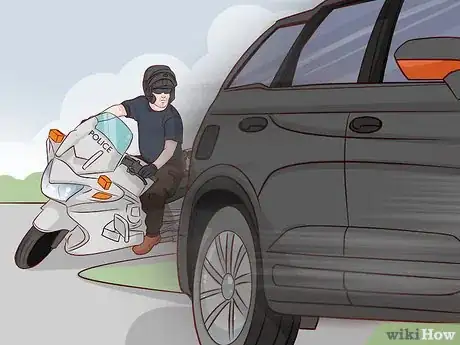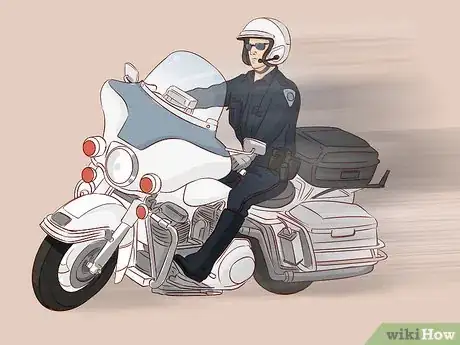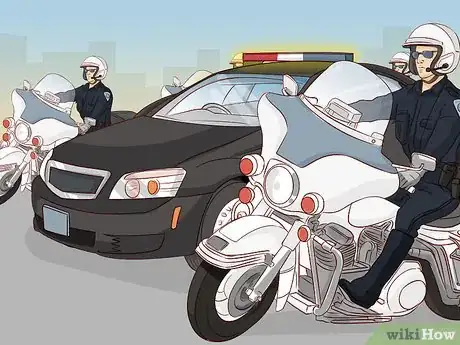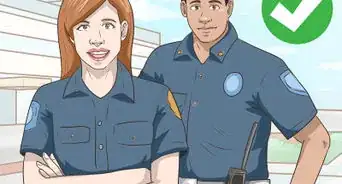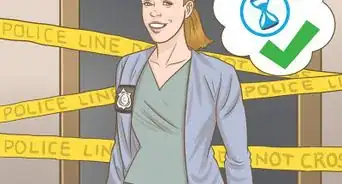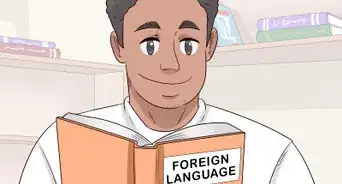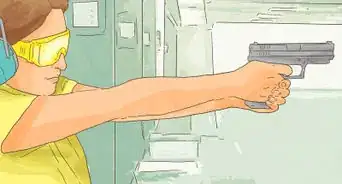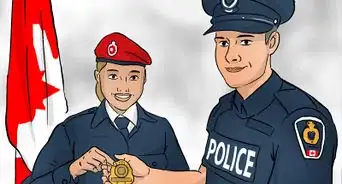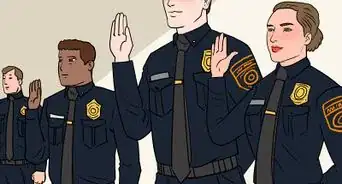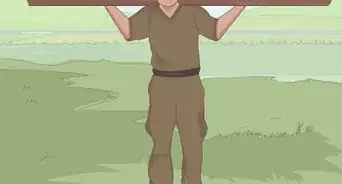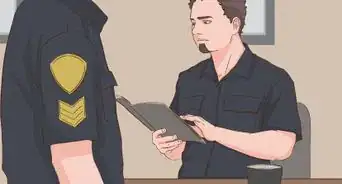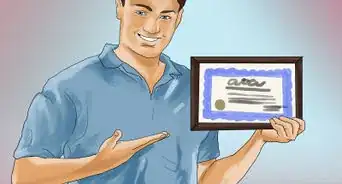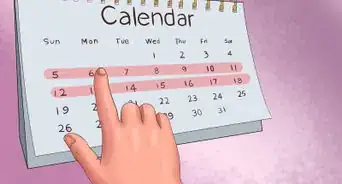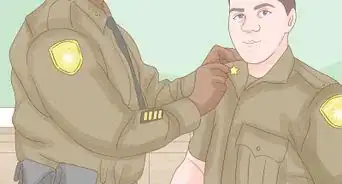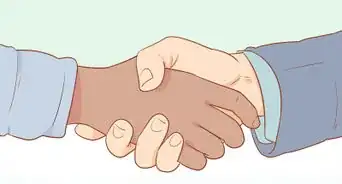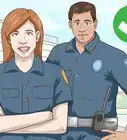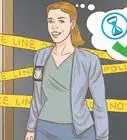This article was co-authored by wikiHow staff writer, Eric McClure. Eric McClure is an editing fellow at wikiHow where he has been editing, researching, and creating content since 2019. A former educator and poet, his work has appeared in Carcinogenic Poetry, Shot Glass Journal, Prairie Margins, and The Rusty Nail. His digital chapbook, The Internet, was also published in TL;DR Magazine. He was the winner of the Paul Carroll award for outstanding achievement in creative writing in 2014, and he was a featured reader at the Poetry Foundation’s Open Door Reading Series in 2015. Eric holds a BA in English from the University of Illinois at Chicago, and an MEd in secondary education from DePaul University.
There are 7 references cited in this article, which can be found at the bottom of the page.
This article has been viewed 13,572 times.
Learn more...
Becoming a motorcycle cop isn’t a particularly difficult task if you’re already a police officer, but it can be quite time consuming since police departments don’t typically have a large number of motorcycle cops and you’ll need to wait for an opening. Generally, any patrol officer with a motorcycle license can apply for open positions in a motorcycle unit. If you aren’t a police officer, apply for the police training program and work hard to graduate from the academy. Spend 3-10 years as a patrol officer before applying for open positions in your department’s motorcycle unit. As a motorcycle cop, you will deter crime, enforce traffic laws, and attend special events like parades and motorcades.
Steps
Getting Qualified as a Police Officer
-
1Apply for a recruit position at your local police academy. Apply for a police training program in the state or district where you want to work. Fill out an application and submit it alongside any other required paperwork. Complete the criminal background check and get a physical to ensure that you meet the physical requirements for the police force where you live.[1]
- If you are already a police officer, skip the steps in this method.
- To qualify as a police officer, you must be at least 18 years old, have a high school diploma, and have a clean criminal history. Some states and regions require officers to possess a college degree, but most departments to do not.
- This process varies from region to region. You may need to pass a series of interviews before you’re accepted into a police academy.
- A motorcycle cop is simply a type of patrol officer. There is no special “motorcycle cop school” or anything like that. It is also not considered a ranking position, like detective, agent, or captain. Any officer with a motorcycle license can become a motorcycle cop.
-
2Attend classes at the academy for 3-6 months and complete the work. If you’re approved, attend the academy for 3-6 months. Study the laws, duties, radio signals, and responsibilities of police officers and review your notes before the test for each class. Workout alongside other recruits and learn how to grapple, pursue suspects, use your gun, and set up a crime scene. Police academies tend to be intense, so make sure that you’re prepared for 3-6 months of hard work before starting![2]
- This is a competitive process and prospects can be rejected or kicked out of the academy at any point in the process, so work hard to graduate.
Advertisement -
3Pass the final police exam and pass the physical test. You will take a final exam after passing your classes. This test typically takes 2-6 hours and assesses everything you learned at the academy. There is also a physical test where you will need to perform sit-ups, pushups, and complete a 1.5–3 miles (2.4–4.8 km) run in a given time. Pass your exams and complete the psychological evaluation to become a cop.[3]
- Some police departments require the physical test to be passed before you’re allowed to enter the academy.
-
4Apply to a police department with a dedicated traffic or motorcycle unit. If you know your ultimate goal is to become a motorcycle cop, apply for openings with police departments that have a dedicated traffic or motorcycle unit. This way, you can develop relationships with the supervisors of the motorcycle squad and establish yourself as a reliable candidate early in your career.[4]
- A traffic unit is a dedicated division of a police force tasked with keeping roadways safe. If there is a motorcycle unit in the department, it will almost always be a subdivision of the traffic unit. Some departments will not have a dedicated traffic unit, but these departments almost never have motorcycle cops. Traffic units are called highway patrols if they’re state police.
- Sometimes, the motorcycle cops are separate from the traffic unit and operate autonomously, like a narcotics or homicide department. In rare instances, motorcycle cops can be found in specialized enforcement units.
- Some police academies hire you after you graduate. If this is the case where you live, stay at your current position for the first 1-3 years instead of applying to a new police force to get some experience.
-
5Work as a standard patrol officer for at least 3 years to get experience. Typically, you cannot even apply for a position in the motorcycle unit for your first 3 years on the job. Spend your first few years on the force as an entry-level patrol officer. Stay on the beat and follow assignments as they’re given. Respond to radio calls, arrest suspects, interview witnesses, and back other officers up while you continue to master your craft.[5]
- Your first 6 months on the force are typically spent on probation—a designation for new officers that means they’re still being trained.
-
6Spend at least 3-10 years in a patrol car and avoid accidents. It usually takes 5-10 years in a patrol car before you will be considered for a motorcycle post. Show up to work on time, perform your duties, and back your fellow officers up. A clean driving record goes a long way to demonstrate your ability to stay safe on the road, so avoid accidents whenever you can. Over time, you will develop a reputation as a solid and dependable officer that may be worthy of a motorcycle position.[6]
- Do not pursue openings in special units if you want to become a motorcycle cop. If you get trained as a narcotics officer, intelligence agent, or some other special type of officer, the police department will not want to send a specially-trained officer on a motorcycle detail.
- If you work in a major city where the motorcycle unit is largely ornamental, it may take even longer to get on a motorcycle.
Tip: The length of this process has more to do with the limited number of openings than the special skills required to be a motorcycle cop. For example, the city of Boise, Idaho has over 300 police officers, but only 12 members of the motorcycle department. It can take a long time for an opening to show up.
Getting into the Motorcycle Unit
-
1Get licensed to operate a motorcycle in the state where you live. You cannot become a motorcycle cop without a motorcycle endorsement on your driver’s license. While the requirements differ from region to region, you get a motorcycle license by signing up for a traffic class or training program. Apply for your learner’s permit and complete the necessary training hours to qualify for a road test where you live. Complete the road test at your local DMV to earn your motorcycle license.[7]
- It often takes 5-10 years for police officers to move to a motorcycle unit, so you can always get your motorcycle license after a few years on the force. You will need to do this before you can apply to be a motorcycle cop, though.
-
2Introduce yourself to the supervisors in the motorcycle or traffic unit. If you are already in the traffic unit and the motorcycle cops are a component of your department, you’ll already know the supervisors. If you don’t though, introduce yourself before or after a shift while you’re hanging around the police station. Shake each supervisor’s hand, tell them who you are, and make some pleasant conversation to begin building a professional relationship.[8]
- If you already drive a motorcycle, taking it to work may be a great way to passively let the supervisors know that you can ride.
Tip: In some departments, the motorcycle unit isn’t actually separate from the traffic unit and the motorcycle cops will answer to the same supervisors as the other members of the unit. In other departments, the motorcycle unit is a completely different division, like the vice squad, narcotics unit, or canine squad.
-
3Let the supervisors of the motorcycle unit know you want to join their team. The best way to get into the motorcycle unit is to ask the supervisors of the unit how you can join. Once they get to know you, ask to speak to the supervisors of the motorcycle unit privately. Express interest in joining their unit and request to get transferred to their team if they seem interested in bringing you on.[9]
- A simple “I’d like to talk to you about joining your team” is a perfectly fine way to initiate the conversation about becoming a motorcycle cop.
- Moving from the standard rotation to the motorcycle unit is usually a lateral move for police officers. Since this isn’t a promotion, feel free to speak openly about wanting to join the unit. You won’t really need to negotiate or be coy about it.
- Do not pester your supervisors if they tell you there are no openings. Motorcycle units tend to be pretty small compared to other groups, and you may simply have to wait.
- If you know any of the motorcycle cops personally, ask them for training tips and advice to see if they have any insight on getting into the unit.
-
4Apply for a motorcycle post as soon as the job becomes available. If the motorcycle unit is an autonomous division, you’ll probably need to apply for a transfer. Write a simple letter expressing interest in the position and explain why you think you’d be a good choice. Compile letters of recommendation from your previous and current ranking officers alongside proof of your motorcycle license. Submit the documents to the designated superior to apply for the opening with the motorcycle unit.[10]
- If the motorcycle unit is a subdivision of the traffic department, you may not need to apply. Your current supervisor may be simply willing to move you over to a motorcycle.
- Your letter can be straightforward, but it shouldn’t focus on how much you like riding a bike. Explain your interest in the position by focusing on the duties of a motorcycle cop. Say something like, “I believe in the importance of traffic safety and I am dedicated to keeping the roads of this community safe. I believe this mission will be easier on a motorcycle where I’ll have a special focus on road safety.”
-
5Interview for the position if necessary. After you’ve applied, you may be asked to interview with the supervisor of the motorcycle unit. If you are invited to interview, show up on time and answer the supervisor’s questions. Express your desire to help keep the public safe and highlight your safety record and driving history. Be cordial and address any of the supervisor’s concerns to give yourself the best shot at the job.[11]
- Motorcycle posts aren’t highly desirable in most departments since it’s more dangerous to ride a bike than drive a car. If there aren’t many applicants and the supervisor knows you, they may give you the position without requesting an interview.
-
6Complete your motor training to become a motorcycle cop. If you’re accepted, you will spend the next 10-30 days in training for the motorcycle unit. This class will cover your new unit’s rules, regulations, and standard operating procedures. You will also be trained on how to operate a police motorcycle, weave safely through traffic, and perform emergency turns, stops, and maneuvers. Show up on time every day and work diligently to complete the coursework as covered by the instructor.[12]
- The motor training typically takes 80-160 hours to complete. Depending on where you live, you may work half-shifts for part of the day and attend class for the remainder of your shift. In some departments, you will simply be taken out of rotation for a few weeks.
- You may start out looking at videos of police motorcycles to study the proper riding form for officers, but you’ll eventually find yourself performing complex driving maneuvers. Don’t get upset if your training feels a little dull at first.
- Motorcycle cops typically all ride the same make and model. You won’t have any control over what type of bike you get. Every department has its own model, but in the United States, they’re typically Triumph or Harley Davidson bikes. In Europe, you’ll usually ride an electric or sport bike.
Working as a Motorcycle Cop
-
1Complete your standard duties as assigned by your department. In general, the duties of a motorcycle cop are not all that different from the duties of a typical officer. Continue to follow your department’s instructions as they’re given to you. Respond to calls, pull over cars, and arrest suspects the same way that you normally would as a typical police officer.[13]
- If you do make an arrest, you will need to request a patrol car to drive the detainee to the police station.
Tip: While your daily focus may be shifted from beat patrol to road safety, your job description will largely remain the same. You’re still arresting criminals, responding to calls, and perform investigations the same way that you did as a standard officer.
-
2Pull over speeding vehicles and enforce the rules of the road. If you are assigned to focus on road safety, report to your assigned post with a radar gun and monitor the speed of drivers. Pull over vehicles that speed or commit moving violations. Write tickets and make arrests as you deem appropriate. If you have a route to cover, drive your assigned path over the course of your shift to keep an eye on the area and deter crime.[14]
- A large portion of a highway patrol officer’s job is to be visible and deter crimes from occurring in the first place. You may have entire shifts where all you do is ride around on your bike to let people know you’re there.
-
3Assist standard patrol cars when signaled over the radio. Due to your ability to maneuver through traffic and take atypical routes, patrol cars may occasionally call you to help them with something. From setting up a checkpoint to investigating a nearby scene for information, the range of your responsibilities will vary from call to call. When you are signaled over the radio, respond to the call and help in any way that you can.[15]
- In a lot of jurisdictions, motorcycle cops aren’t actually allowed to do a lot of the things that a patrol car does, like set up spike strips, engage in pursuits, or follow vehicles over a long distance. Because of these restrictions, motorcycle cops are often used in an assisting capacity.
-
4Respond to crime scenes as fast as possible by safely weaving through traffic. When you get an emergency call on the radio, you may be requested to respond. If an officer calls for backup or you are asked to respond to a call, weave through traffic or drive on the shoulder of the road to arrive as fast as possible. Do not take any unnecessary risks, but do your best to get there quickly to assist on the scene.[16]
- Motorcycle cops are often called to get to crime scenes because they can weave through traffic and take nontraditional routes. While squad cars may get stuck in traffic or outmaneuvered, you can use your riding skills to beat suspects to a location, show up quickly, and provide backup without wasting time in a bulky squad car.
-
5Avoid high-speed pursuits unless the suspect is a violent offender. If a vehicle refuses to pull over or the driver has committed a crime and is on the run, do not pursue the vehicle. Instead, radio the position in, give an approximate description of the vehicle and suspect, and either follow at a slower speed or hand the call off to a patrol car. Motorcycle cops are almost universally banned from engaging in high-speed pursuits since they’re too dangerous on a bike. An exception is usually made for violent offenders that may harm the public.[17]
- If you do need to engage in a chase, peel off of the pursuit as soon as a patrol car arrives and hand the task over to the car.
-
6Engage in community outreach, special events, and parades. Show up to special events like funerals, parades, and community events as you’re directed. You may also be asked to ride in a motorcade or hang out in a high-traffic area to talk to the public. These assignments are more about appearances than law enforcement, so show up ready to smile and chat with people to make your department look good.
- This is an especially common job if you’re working in a major city where public relations and community engagement are especially important.
Community Q&A
-
QuestionWhat age do you have to be to become a motorcycle police officer?
 Colin WhaleyCommunity AnswerYou should be 18 years old, have a high school diploma, and have a clean criminal record.
Colin WhaleyCommunity AnswerYou should be 18 years old, have a high school diploma, and have a clean criminal record.
References
- ↑ https://www.chp.ca.gov/chp-careers/officer/why-become-a-chp-officer/minimum-requirements-officer
- ↑ https://www.chp.ca.gov/chp-careers/officer/why-become-a-chp-officer/minimum-requirements-officer
- ↑ https://www.policetest.info/physical#
- ↑ https://namoa.org/how-to-become-a-motor-officer/
- ↑ https://namoa.org/how-to-become-a-motor-officer/
- ↑ https://namoa.org/how-to-become-a-motor-officer/
- ↑ https://www.drivingtests.co.nz/resources/police-motorbikes-and-how-to-ride-them-becoming-a-traffic-officer/
- ↑ https://namoa.org/how-to-become-a-motor-officer/
- ↑ https://namoa.org/how-to-become-a-motor-officer/
- ↑ https://uwpd.wisc.edu/content/uploads/2015/08/41.7-Police-Motorcycle-Unit-11.14.pdf
- ↑ https://uwpd.wisc.edu/content/uploads/2015/08/41.7-Police-Motorcycle-Unit-11.14.pdf
- ↑ https://www.thedrive.com/emergency/12446/check-out-the-rigorous-training-police-motorcycle-units-have-to-go-through
- ↑ https://uwpd.wisc.edu/content/uploads/2015/08/41.7-Police-Motorcycle-Unit-11.14.pdf
- ↑ https://www.hotcars.com/things-most-people-dont-know-about-police-motorcycles/
- ↑ https://uwpd.wisc.edu/content/uploads/2015/08/41.7-Police-Motorcycle-Unit-11.14.pdf
- ↑ https://www.hotcars.com/things-most-people-dont-know-about-police-motorcycles/
- ↑ https://uwpd.wisc.edu/content/uploads/2015/08/41.7-Police-Motorcycle-Unit-11.14.pdf
